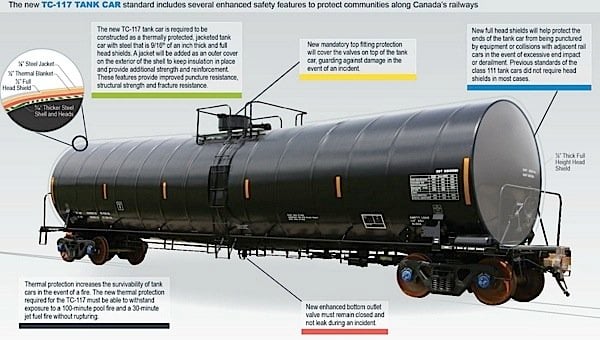A new class of tank car with enhanced safety features to make it safer for transporting flammable liquids such as crude oil and ethanol was announced by Canada and the US. The new standard, TC-117, requires thicker steel, full head shield protection, thermal protection, top fitting protection and bottom outlet improvements. In all, approximately 43,000 existing tank cars in the railways’ crude oil fleets will have to be phased out or retrofitted by 2020. An additional 20,000 cars in the ethanol fleet have to be retrofitted or replaced by 2023.
The Railway Association of Canada has said it supports the new harmonized standard for tank cars. Its US counterpart, the Association of American Railroads (AAR), also supports the standard in general, but strongly opposes a key component of the US regulation. That rule requires either the use of electronically controlled pneumatic brakes (ECP) or the imposition of a speed limit of 30 mph on trains carrying the most dangerous liquids. AAR president and CEO Edward Hamberger said the US Department of Transportation has no substantial evidence to justify mandating ECP brakes. Further, the 30 mph speed limit threatens the railway network’s capacity by “at least 30 per cent.” Both CN and CP railways in Canada have also expressed serious concerns about ECP brakes. The slow-moving trains, he said, will back up the entire rail system. The American Petroleum Institute also complained that the time for retrofitting tank cars is too short.
Canada’s Minister of Transport, Lisa Raitt, acknowledged that the new safety measures will not be easy and “quite frankly, will not be cheap.” But, she said, the costs of cleaning up after accidents like Lac Megantic would, in the long run, be more “burdensome.” It is estimated that the cost of the retrofit will be about $2.5 billion.
The new US braking requirement applies to trains having at least 70 cars, of which at least one is carrying crude or volatile liquids. ECB brakes automatically stop all the cars at the same time. The regulation takes effect on January 1, 2021. Lisa Raitt, Canada’s Minister of Transport, said that Canada is working on its own braking regulation.
While rail car manufacturers and railway companies in the US are angry about the too-short timeline for implementing the new standard, safety advocates and some members of Congress say the timeline is too long.
The railway industry in the United States is also far from accepting that transporting crude by rail is getting more dangerous, a common perception that is partly fueled by disasters like the Lac Megantic derailment. A spokesman for AAR told NBC news that railroads are safer now than ever before. While the number of accidents involving tanker cars has increased, it must be remembered that the volume of crude oil shipping in 2015 is 40 times greater than it was in 2005. According to the US government’s own Pipeline and Hazardous Materials Safety Administration, 87,000 tank cars were used to transport crude oil in 2014, and 141 crude “releases” were reported. The amount of oil released in these spills was less than the capacity of two tank cars.


































